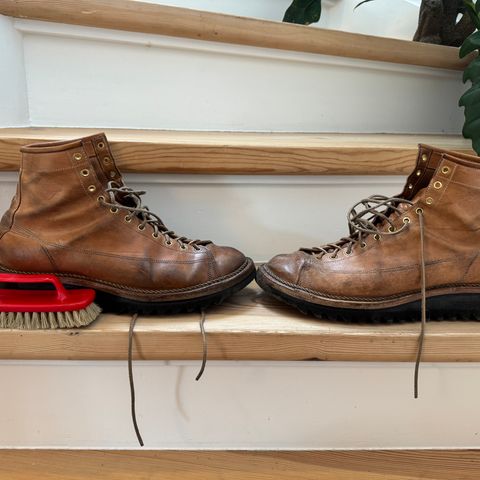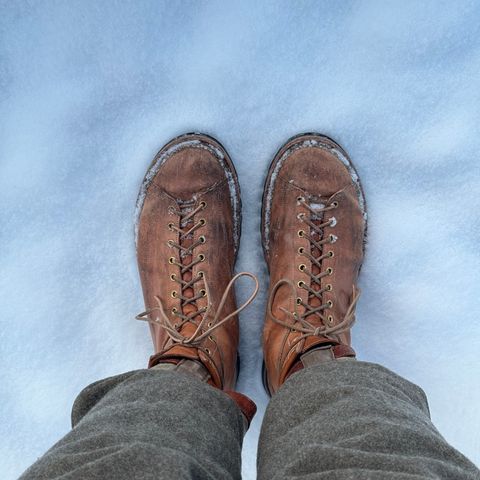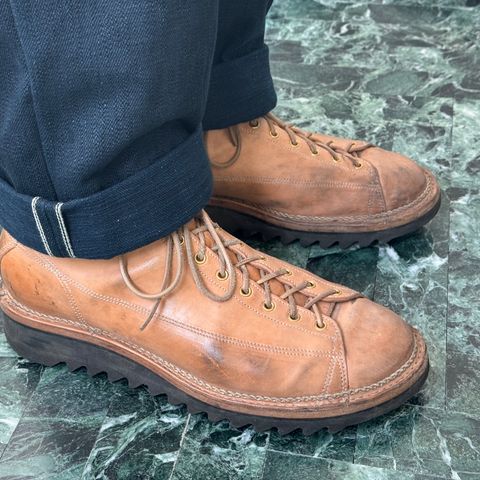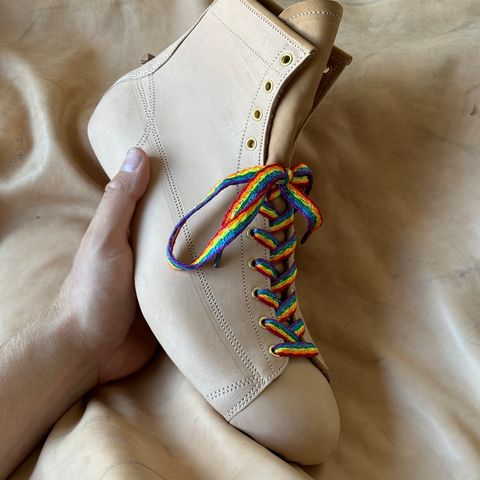About
Conceria Cloe Crust Horsebutt is an undyed vegetable-tanned leather produced by Conceria Cloe, an Italian tannery located in Ponte a Égola, Tuscany. This leather combines the natural character of crust finishing with the dense fiber construction of horsebutt hide, resulting in a material that develops patina through wear while maintaining minimal processing from the tannery.
About
Conceria Cloe Crust Horsebutt is an undyed vegetable-tanned leather produced by Conceria Cloe, an Italian tannery located in Ponte a Égola, Tuscany. This leather combines the natural character of crust finishing with the dense fiber construction of horsebutt hide, resulting in a material that develops patina through wear while maintaining minimal processing from the tannery.
Crust leather is rawhide that has been tanned but not dyed, receiving color application after the tannage process rather than during manufacturing. This finishing approach preserves the leather's natural characteristics and allows for custom coloring by bootmakers and craftspeople. The horsebutt portion of the hide is cut from the hind section, positioned above the shell cordovan layer, and contains dense fiber construction that provides strength and durability.
Characteristics
Conceria Cloe's crust horsebutt exhibits several distinctive physical properties. The leather has a very soft texture with subtle grain variation and a dry, matte touch. The material contains high oil content that contributes to patina susceptibility, developing a lustrous, almost metallic shine over time. Residual traces of shell cordovan remain visible on the reverse side, creating an irregular appearance with varied sections across the hide.
The crust finishing process results in leather that is softer than drum-dyed alternatives, as dyeing processes tend to stiffen leather. The material achieves shine more readily and breaks in faster than fully finished leathers. However, crust leather is more susceptible to moisture damage and staining than finished alternatives, with environmental exposure more easily compromising the finish. The material's hand-feel is described as soft, gummy, and stretchy, with grain patterns showing highly irregular characteristics and significant variation across different areas.
The leather can be manually altered through polishing and dyeing, allowing craftspeople to introduce depth and color variation. This manipulability enables customization while the undyed state serves as a foundation for creating unique finishes and patinas over time.
Production process
Conceria Cloe produces this leather using traditional vegetable tanning methods in the Tuscan leather district that spans between Florence and Pisa provinces. The region developed tanning production around 1200, with Santa Croce becoming an important leather market and Ponte a Égola emerging as a center for vegetable-tanned leather production. The district now produces 98 percent of Italy's sole leather and 35 percent of national leather production, with approximately 900 small-to-medium enterprises operating in the specialized sector.
The vegetable tanning process employs natural tannins extracted from plants to treat the leather. Traditional methods were influenced by Napoleonic armies introducing French techniques of soaking leather in wooden half-barrels under tree bark. The transition from craft to industrial activity accelerated around 1700, with rotating drums replacing traditional tanks in the 1800s.
For horsebutt production, the hide is cut 18 inches from the tail root along the backbone, creating front and butt sections. The butt portion can be processed in different ways. For shell cordovan, the butt is passed through a splitting-machine that removes the grain (hair side) to reveal the shell membrane beneath. The shell cordovan tanning requires at least six months, involving vegetable tanning, hand-currying, and hand-glazing for a glossy finish.
In contrast, horsebutt retains the whole horse butt with the shell still embedded—the leather is never shaved to expose the membrane. The material undergoes combination tanning: 30 days in cordovan vats followed by chrome re-tanning. The result is significantly firmer than shell cordovan alone and is hot-stuffed with oils and waxes before hand-finishing with stains. For crust horsebutt, this finishing process stops before dyeing, leaving the leather in its natural, undyed state with standard thickness of 1.8-2.0mm.
Applications
Conceria Cloe's crust horsebutt finds use in heritage footwear construction and leather goods production. The dense fiber construction and flexibility of horse rump leather make it suitable for boots requiring durability without intensive upkeep. The material tends to be more flexible and breathable than shell cordovan while maintaining a natural appearance.
In footwear applications, the leather appears in handwelted flat welt construction with 270-degree outsole stitching. Bootmakers may use the reverse or flesh side of the hide for different aesthetic effects. The leather's ability to accept manual coloring allows bootmakers to create custom finishes specific to individual orders.
The material also serves wallet production, including bifold and Japanese wallet styles in reverse cut applications. The limited usable area per hide restricts applications to smaller leather goods and select footwear projects. Watch straps represent another application where the material's patina development and natural character provide aesthetic value.
References
"Horse Culatta - Cloe S.R.L". Mill Handmade. Retrieved October 23, 2025.
"What Is Crust Leather?". The Shoe Snob. Retrieved October 23, 2025.
"Shell Cordovan Leather FAQs". The Tannery Row. Retrieved October 23, 2025.
"Shell cordovan". Wikipedia. Retrieved October 23, 2025.
"Tuscan Tanning". Google Arts & Culture. Retrieved October 23, 2025.






















































